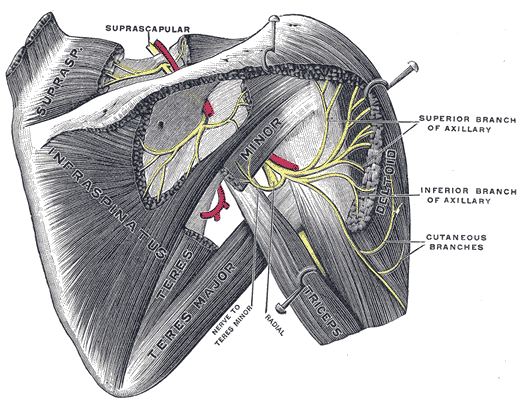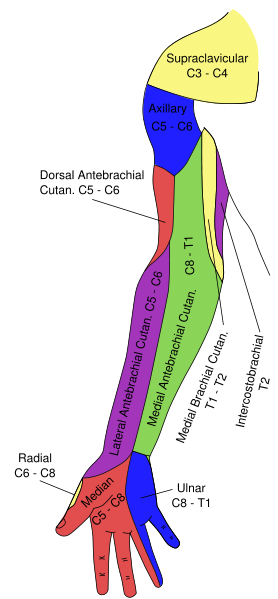Axillary nerve
Template:Infobox Nerve Editor-In-Chief: C. Michael Gibson, M.S., M.D. [1]
The axillary nerve is a nerve of the human body, that comes off the posterior cord of the brachial plexus at the level of the axilla (armpit) and carries nerve fibers from C5 and C6. The axillary nerve travels through the quadrangular space with the posterior circumflex humeral artery and vein.
Muscular and sensory innervation
It supplies two muscles, deltoid (a muscle of the shoulder), and teres minor (one of the rotator cuff muscles).
The axillary nerve also carries sensory information from the shoulder joint, as well as the skin covering the inferior region of the deltoid muscle (which is innervated by the Superior Lateral Cutaneous Nerve branch of the Axillary nerve).
When the axillary nerve splits off from the posterior cord, the continuation of the cord is the radial nerve.
Branches
It lies at first behind the axillary artery, and in front of the Subscapularis, and passes downward to the lower border of that muscle.
It then winds backward, in company with the posterior humeral circumflex artery, through a quadrilateral space bounded above by the Teres Minor, below by the Teres major, medially by the long head of the Triceps brachii, and laterally by the surgical neck of the humerus, and divides into an anterior and a posterior branch.
- The anterior branch (upper branch) winds around the surgical neck of the humerus, beneath the Deltoideus, with the posterior humeral circumflex vessels, as far as the anterior border of that muscle, supplying it, and giving off a few small cutaneous branches, which pierce the muscle and ramify in the skin covering its lower part.
- The posterior branch (lower branch) supplies the Teres minor and the posterior part of the Deltoideus; upon the branch to the Teres minor an oval enlargement (pseudoganglion) usually exists. The posterior branch then pierces the deep fascia and is continued as the lateral brachial cutaneous nerve, which sweeps around the posterior border of the Deltoideus and supplies the skin over the lower two-thirds of the posterior part of this muscle, as well as that covering the long head of the Triceps brachii.
The trunk of the axillary nerve gives off an articular filament which enters the shoulder-joint below the Subscapularis.
Injury
The axillary nerve may be injured in anterior dislocations of the shoulder joint, compression of the axilla with a crutch or fracture of the surgical neck of the humerus. Injury to the nerve results in: -
1. Paralysis of the teres minor and deltoid muscles. Abduction of the shoulder is impaired.
2. Loss of sensation over a small part of the lateral upper arm
Additional images
-
Brachial plexus
-
Suprascapular and axillary nerves of right side, seen from behind.
-
Cutaneous nerves of right upper extremity. Anterior view.
-
Diagram of segmental distribution of the cutaneous nerves of the right upper extremity. Anterior view.
-
Cutaneous nerves of right upper extremity. Posterior view.
-
Diagram of segmental distribution of the cutaneous nerves of the right upper extremity. Posterior view.
-
Back of right upper extremity, showing surface markings for bones and nerves.


